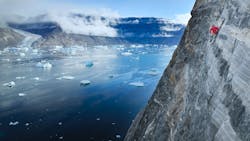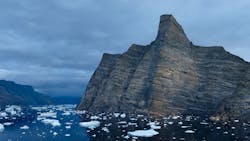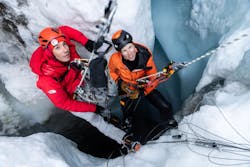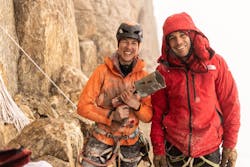Monitoring Climate Change While Climbing in “Artic Ascent with Alex Honnold”
What you’ll learn:
- A look at Nat Geo’s Artic Ascent docuseries.
- The gear used to create the series.
- Awareness of climate change's impact on Arctic environments and the world at large.
National Geographic is embarking on an incredible journey and focusing its lenses on the issue of climate change with its latest series, “Arctic Ascent with Alex Honnold.” In an adventurous and impactful move, the renowned institution is looking into the heart of environmental challenges, using its influential platform to educate, inspire, and spark meaningful conversations about the future of our planet. The new series promises to be more than a visual docuseries—it aims to be a rallying call for global action and awareness.
The series captures world-renowned climber Alex Honnold and his team's attempt to summit Greenland’s 3,750-foot rock formation Ingmikortilaq (Ing-mik-or-tuh-lack), a peak no one has climbed in recorded history, to discover the impact of climate change in remote areas (Fig. 1).
“We literally went off the edge of the map to reach this wall,” stated Honnold via satellite phone, referring to the nautical maps the team had been following, which offered no details about the fjord where the rock formation is located. “It is definitely one of the biggest first ascents I’ve ever done–and one of the most stressful due to how dangerous the climbing was.”
Test & Measurement Techniques
The goal for Honnold and his team was to help scientist Heidi Sevestre, a French glaciologist working with the Arctic Monitoring and Assessment Program, gain access to glaciers, remote fjords, and the Renland Ice Cap, located on a high mountain plateau near Scoresby Sound. Once at the top, the climbers spent five days pulling a sled-like device containing a special radar that took real-time measurements of the depth and density of the snow and ice.
A total of 15 different research techniques were employed during the expedition, including placing temperature sensors on cliffs, scanning inside glaciers with 3D imaging systems, and launching a NASA-designed sensor platform into the fjord that will garner data about temperature and the salinity of the ocean over the next two years (Figs. 2 and 3).
Climbing the Arctic cliff up 3,750 feet in 20°F weather during a snowstorm is an accomplishment in itself, more so when the climb is graded at 5.12c, a number that describes its difficulty (denoting difficulty of handholds and the moves involved). Add to that the amount of gear the climbers had to haul up the face, and the term “logistical nightmare” doesn’t do it justice.
Beyond tents, meals, and clothing, the team also brought a ton of scientific equipment, including ablation poles to measure glacier melt, time-lapse cameras, 3D mapping equipment, hydrophones, temperature sensors, piezometers to measure water pressure, CTDs (CTD = conductivity, temperature, depth) to measure water salinity, GPS systems, satellite phones, and radar equipment. This is on top of containers for taking rock and water samples, increasing the weight for the trip down.
The equipment was a necessary burden for Alex and his team. The determination to go where no climbers have gone before, hauling equipment on toboggans, and documenting the journey every step of the way places viewers in a unique world that could soon fade away over the coming decades.
The journey undertaken in National Geographic’s new docuseries doesn’t conclude with the end of an adventure, but with a renewed commitment to bring awareness to something that affects the entire planet and acts as a catalyst for change. The “Arctic Ascent with Alex Honnold” is set to premiere on February 5 on Disney+.
When asked if Arctic Ascent got Heidi into climbing, she said, “Absolutely! And I also want to work with other athletes on other expeditions, too.”
When asked if Arctic Ascent got Alex into exploring more science, he replied, “Without a doubt. I want to have a scientific component on every one of my major climbs.”
About the Author
Cabe Atwell
Technology Editor, Electronic Design
Cabe is a Technology Editor for Electronic Design.
Engineer, Machinist, Maker, Writer. A graduate Electrical Engineer actively plying his expertise in the industry and at his company, Gunhead. When not designing/building, he creates a steady torrent of projects and content in the media world. Many of his projects and articles are online at element14 & SolidSmack, industry-focused work at EETimes & EDN, and offbeat articles at Make Magazine. Currently, you can find him hosting webinars and contributing to Electronic Design and Machine Design.
Cabe is an electrical engineer, design consultant and author with 25 years’ experience. His most recent book is “Essential 555 IC: Design, Configure, and Create Clever Circuits”
Cabe writes the Engineering on Friday blog on Electronic Design.




